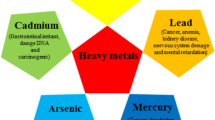Abstract
Serious cases of arsenic toxicity of people drinking water have led to the development of water purification methods. For instance, arsenic can be removed from water by adsorption on natural iron oxides. The use of iron oxide from waste could decrease the cost and recycle iron. Here, we studied arsenic removal from contaminated water using iron oxide wastes from a pickling unit of a steel plant. This iron oxide was reduced to magnetic iron oxide in a fluidised bed reactor. We tested arsenic removal from As-spiked solutions and from contaminated waters from West Bengal. Results showed more than 90 % arsenic removal within 10 min. The arsenic concentration of contaminated waters was decreased from 0.010–0.018 to 0.002–0.008 mg/L. We also found that the occurrence of SO4 2−and PO4 3− decreased arsenic adsorption. Iron oxide waste is therefore a new low-cost and effective arsenic adsorbent to clean water.




Similar content being viewed by others
References
Asta MP, Cama J, Martínez M, Giménez J (2009) Arsenic removal by goethite and jarosite in acidic conditions and its environmental implications. J Hazard Mater 171:965–972
Bhattacharyya D, Mukherjee PK, Ray AK, Sengupta S (2004) Arsenic-polluted ground water in West Bengal: a cost-effective remedy. Current Sci 86(9):1206–1209
Behera RK, Rout K, Nayak B, Das NN (2012) Removal of selenium and arsenic oxyanions using natural goethite-rich iron ore from Daitari, Orissa, India: effect of heat treatment. Adsorpt Sci Technol 30(10):867–879
Bujňáková Z, Baláž P, Zorkovská A, Sayagués MJ, Kováč J, Timko M (2013) Arsenic sorption by nanocrystalline magnetite: an example of environmentally promising interface with geosphere. J Hazard Mater. doi:10.1016/j.jhazmat.2013.03.007
Chaurasia N, Mishra AN, Pandey SK (2012) Finger print of arsenic contaminated water in India—a review. J Forensic Res 3(10):1–4
Chiban M, Zerbet M, Carja G, Sinan F (2012) Application of low-cost adsorbents for arsenic removal: a review. J Environ Chem Ecotoxicol 4(5):91–102. doi:10.5897/JECE11.013
EPA Office of Groundwater and Drinking Water (2002) Implementation guidance for the arsenic rule. EPA Report-816-D-02-005 (2002), Cincinnati, OH, USA
Feng L, Cao M, Ma X, Zhu Y, Hu C (2012) Superparamagnetic high-surface-area Fe3O4 nanoparticles as adsorbents for arsenic removal. J Hazard Mater 217–218:439–446
Fiol N, Villaescusa I (2009) Determination of sorbent point zero charge: usefulness in sorption studies. Environ Chem Lett 7:79–84
Giménez J, Martínez M, Pablo J, Rovira M, Duro L (2007) Arsenic sorption onto natural hematite, magnetite, and goethite. J Hazard Mater 141:575–580
Guan X, Dong H, Ma J, Jiang L (2009a) Removal of arsenic from water: effects of competing anions on As(III) removal in KMnO4–Fe(II) process. Water Res 43:3891–3899
Guan X, Ma J, Dong H, Jiang L (2009b) Removal of arsenic from water: effect of calcium ions on As(III) removal in the KMnO4–Fe(II) process. Water Res 43:5119–5128
Guo H, Stuben D, Berner Z (2007) Removal of arsenic from aqueous solution by natural siderite and hematite. Appl Geochem 22:1039–1051
Li L, Li J, Shao C, Zhang K, Yu S, Gao N, Deng Y, Yin D (2014) Arsenic removal in synthetic ground water using iron electrolysis. Sep Purif Technol 122:225–230
Ma L, Tu SX (2011) Removal of arsenic from aqueous solution by two types of nanoTiO2 crystals. Environ Chem Lett 9:465–472
Mamindy-Panjany Y, Hurel C, Marmier N, Romeo M (2009) Arsenic adsorption onto hematite and goethite. C R Chim 12:876–881
Mazumder DNG (2008) Chronic arsenic toxicity & human health. Indian J Med Res 128:436–447
Mohan D, Pittman-Jr CU (2007) Arsenic removal from water/wastewater using adsorbents—a critical review. J Hazard Mater 142:1–53
Mukherjee A, Sengupta MK, Hossain MA, Ahamed S, Das B, Nayak B, Lodh D, Rahman MM, Chakraborti D (2006) Arsenic contamination in groundwater: a global perspective with emphasis on the Asian scenario. J Health Popul Nutr 24(2):142–163
Tian Y, Wu M, Lin X, Huang P, Huang Y (2011) Synthesis of magnetic wheat straw for arsenic adsorption. J Hazard Mater 193:10–16
United States Environmental Protection Agency (2000) Technologies and costs for removal of arsenic from drinking water, EPA 815-R-00-028. http://water.epa.gov/drink/info/arsenic/upload/2005_11_10_arsenic_treatments_and_costs.pdf. Accessed on 04-02-2014
United States Environmental Protection Agency (2014) Arsenic in drinking water. http://water.epa.gov/lawsregs/rulesregs/sdwa/arsenic/index.cfm. Accessed on 04-02-2014
Villaescusa I, Bollinger JC (2008) Arsenic in drinking water: sources, occurrence and health effects (a review). Rev Environ Sci Biotechnol 7:307–323
Zhang W, Sing P, Pailing E, Delides A (2004) Arsenic removal from contaminated water by natural iron ores. Miner Eng 17:517–524
Acknowledgments
Authors show sincere gratitude to the Director, CSIR-NML (Jamshedpur) for permission to carry out the reported work.
Author information
Authors and Affiliations
Corresponding author
Rights and permissions
About this article
Cite this article
Randhawa, N.S., Murmu, N., Tudu, S. et al. Iron oxide waste to clean arsenic-contaminated water. Environ Chem Lett 12, 517–522 (2014). https://doi.org/10.1007/s10311-014-0477-z
Received:
Accepted:
Published:
Issue Date:
DOI: https://doi.org/10.1007/s10311-014-0477-z




